DNA Intercalating Near-Infrared Luminescent Lanthanide Complexes Containing Dipyrido[3,2-a:2′,3′-c]phenazine (dppz) Ligands: Synthesis, Crystal Structures, Stability, Luminescence Properties and CT-DNA Interaction
Abstract
1. Introduction
2. Results and Discussion
2.1. Synthesis of the Ligand and Complexes
2.2. Spectroscopic Study
2.3. Single Crystal X-ray Analysis
2.4. Photoluminescence Study
2.5. UV/Vis Stability Tests
2.6. CT-DNA Interaction Tests
3. Materials and Methods
3.1. Synthesis
3.2. Characterization
3.3. Synthesis of the Ligand
3.3.1. Synthesis of the Ligand Precursor 1,10-phenanthroline-5,6-dione (Phendione)
3.3.2. Synthesis of the Ligand Dipyrido[3,2-a:2′,3′-c]phenazine (dppz)
3.4. Synthesis of the Complexes
3.5. Solubility and Stability of Complexes
3.6. Single Crystal X-ray Diffraction Analysis
3.7. CT-DNA Binding Study
4. Conclusions
Supplementary Materials
Author Contributions
Funding
Conflicts of Interest
References
- Eliseeva, S.V.; Bünzli, J.-C.G. Lanthanide luminescence for functional materials and bio-sciences. Chem. Soc. Rev. 2010, 39, 189–227. [Google Scholar] [PubMed]
- Binnemans, K. Lanthanide-based luminescent hybrid materials. Chem. Rev. 2009, 109, 4283–4374. [Google Scholar] [CrossRef] [PubMed]
- Werts, M.H.V. Making sense of lanthanide luminescence. Sci. Prog. 2005, 88, 101–131. [Google Scholar] [CrossRef] [PubMed]
- Bünzli, J.-C.G. On the design of highly luminescent lanthanide complexes. Coord. Chem. Rev. 2015, 293, 19–47. [Google Scholar] [CrossRef]
- Bünzli, J.-C.G.; Eliseeva, S.V. Intriguing aspects of lanthanide luminescence. Chem. Sci. 2013, 4, 1939–1949. [Google Scholar] [CrossRef]
- Debroye, E.; Parac-Vogt, T.N. Towards polymetallic lanthanide complexes as dual contrast agents for magnetic resonance and optical imaging. Chem. Soc. Rev. 2014, 43, 8178–8192. [Google Scholar] [CrossRef]
- Morrow, J.R.; Buttrey, L.A.; Shelton, V.M.; Berback, K.A. Efficient catalytic cleavage of RNA by lanthanide(III) macrocyclic complexes—Toward synthetic nucleases for invivo applications. J. Am. Chem. Soc. 1992, 114, 1903–1905. [Google Scholar] [CrossRef]
- Franklin, S.J. Lanthanide-mediated DNA hydrolysis. Curr. Opin. Chem. Biol. 2001, 5, 201–208. [Google Scholar] [CrossRef]
- Larson, S.M.; Carrasquillo, J.A.; Cheung, N.K.V.; Press, O.W. Radioimmunotherapy of human tumours. Nat. Rev. Cancer 2015, 15, 347–360. [Google Scholar] [CrossRef]
- Park, J.Y.; Chang, Y.; Lee, G.H. Multi-modal imaging and cancer therapy using lanthanide oxide nanoparticles: Current status and perspectives. Curr. Med. Chem. Biol. 2015, 22, 569–582. [Google Scholar] [CrossRef]
- Bünzli, J.-C.G.; Eliseeva, S.V. Lanthanide NIR luminescence for telecommunications, bioanalyses and solar energy conversion. J. Rare Earths 2010, 6, 824–842. [Google Scholar] [CrossRef]
- Bünzli, J.-C.G.; Piguet, C. Taking advantage of luminescent lanthanide ions. Chem. Soc. Rev. 2005, 34, 1048–1077. [Google Scholar] [CrossRef] [PubMed]
- Singh, K.; Banerjee, S.; Patra, A.K. Photocytotoxic luminescent lanthanide complexes of DTPA-bisamide using quinoline as photosensitizer. RSC Adv. 2015, 5, 107503–107513. [Google Scholar] [CrossRef]
- Chandra, A.; Singh, K.; Singh, S.; Sivakumar, S.; Patra, A.K. A luminescent europium(III)-platinum(II) heterometallic complex as a theranostic agent: A proof-of-concept study. Dalton Trans. 2016, 45, 494–497. [Google Scholar] [CrossRef] [PubMed]
- Hussain, A.; Somyajit, K.; Banik, B.; Banerjee, S.; Nagaraju, G.; Chakravarty, A.R. Enhancing the photocytotoxic potential of curcumin on terpyridyl lanthanide(III) complex formation. Dalton Trans. 2013, 42, 182–195. [Google Scholar] [CrossRef]
- Campello, M.P.C.; Palma, E.; Correia, I.; Paulo, P.M.R.; Matos, A.; Rino, J.; Coimbra, J.; Pessoa, J.C.; Gambino, D.; Paulo, A.; et al. Lanthanide complexes with phenanthroline-based ligands: Insights into cell death mechanisms obtained by microscopy techniques. Dalton Trans. 2019, 48, 4611–4624. [Google Scholar] [CrossRef]
- Bünzli, J.-C.G. Lanthanide luminescence for biomedical analyses and imaging. Chem. Rev. 2010, 110, 2729–2755. [Google Scholar] [CrossRef]
- Sun, Q.; Yan, P.; Niu, W.; Chu, W.; Yao, X.; An, G.; Li, G. NIR luminescence of a series of benzoyltrifluoroacetone erbium complexes. RSC Adv. 2015, 5, 65856–65861. [Google Scholar] [CrossRef]
- Fan, S.; Yao, X.; Li, J.; Li, W.; Li, G. Near-infrared luminescent materials: From β-diketonate ytterbium complexes to β-diketonate-ytterbium-complex@PMMA thin film. J. Lumin. 2018, 203, 473–480. [Google Scholar] [CrossRef]
- Dasari, S.; Singh, S.; Kumar, P.; Sivakumar, S.; Patra, A.K. Near-infrared excited cooperative upconversion in luminescent ytterbium(III) bioprobes as light-responsive theranostic agents. Eur. J. Med. Chem. 2019, 163, 546–559. [Google Scholar] [CrossRef]
- McQuaid, K.T.; Cardin, C.J. Chapter Twelve—The eyes have it: Using X-ray crystallography to determine the binding modes of medically relevant ruthenium/DNA complexes. Adv. Inorg. Chem. 2020, 75, 393–424. [Google Scholar]
- Hussain, A.; Lahiri, D.; Begum, M.S.A.; Saha, S.; Majumdar, R.; Dighe, R.R.; Chakravarty, A.R. Photocytotoxic lanthanum(III) and gadolinium(III) complexes of phenanthroline bases showing light-induced DNA cleavage activity. Inorg. Chem. 2010, 49, 4036–4045. [Google Scholar] [CrossRef] [PubMed]
- Zheng, R.H.; Guo, H.C.; Jiang, H.J.; Xu, K.H.; Liu, B.B.; Sun, W.L.; Shen, Z.Q. A new and convenient synthesis of phendiones oxidated by KBrO3/H2SO4 at room temperature. Chin. Chem. Lett. 2010, 21, 1270–1272. [Google Scholar] [CrossRef]
- Dupureur, C.M.; Barton, J.K. Structural studies of lambda- and delta-[Ru(phen)(2)dppz](2+) bound to d(GTCGAC)(2): Characterization of enantioselective intercalation. Inorg. Chem. 1997, 36, 33–43. [Google Scholar] [CrossRef]
- Dasari, S.; Patra, A.K. Luminescent europium and terbium complexes of dipyridoquinoxaline and dipyridophenazine ligands as photosensitizing antennae: Structures and biological perspectives. Dalton Trans. 2015, 44, 19844–19855. [Google Scholar] [CrossRef]
- Chen, W.T.; Fukuzumi, S. Ligand-dependent ultrasonic-assistant self-assemblies and photophysical properties of lanthanide nicotinic/isonicotinic complexes. Inorg. Chem. 2009, 48, 3800–3807. [Google Scholar] [CrossRef]
- Monguzzi, A.; Tubino, R.; Meinardi, F.; Biroli, A.O.; Pizzotti, M.; Demartin, F.; Quochi, F.; Cordella, F.; Loi, M.A. Novel Er3+ perfluorinated complexes for broadband sensitized near infrared emission. Chem. Mater. 2009, 21, 128–135. [Google Scholar] [CrossRef]
- Glover, P.B.; Bassett, A.P.; Nockemann, P.; Kariuki, B.M.; Van Deun, R.; Pikramenou, Z. Fully fluorinated imidodiphosphinate shells for visible- and NIR-emitting lanthanides: Hitherto unexpected effects of sensitizer fluorination on lanthanide emission properties. Chem. Eur. J. 2007, 13, 6308–6320. [Google Scholar] [CrossRef]
- Dasari, S.; Abbas, Z.; Kumar, P.; Patra, A.K. Photosensitized samarium(III) and erbium(III) complexes of planar N,N-donor heterocyclic bases: Crystal structures and evaluation of biological activity. CrystEngComm 2016, 18, 4313–4322. [Google Scholar] [CrossRef]
- Horrocks, W.D., Jr.; Sudnick, D.R. Lanthanide ion probes of structure in biology—Laser-induced luminescence decay constants provide a direct measure of the number of metal-coordinated water molecules. J. Am. Chem. Soc. 1979, 101, 334–340. [Google Scholar] [CrossRef]
- Beeby, A.; Clarkson, I.M.; Dickins, R.S.; Faulkner, S.; Parker, D.; Royle, L.; de Sousa, A.S.; Williams, J.A.G.; Woods, M.J. Non-radiative deactivation of the excited states of europium, terbium and ytterbium complexes by proximate energy-matched OH, NH and CH oscillators: An improved luminescence method for establishing solution hydration states. J. Chem. Soc. Perkin Trans. 1999, 2, 493–504. [Google Scholar] [CrossRef]
- Chen, G.-J.; Qiao, X.; Tian, J.-L.; Xu, J.-Y.; Gu, W.; Liu, X.; Yan, S.-P. Synthesis, DNA binding, photo-induced DNA cleavage and cytotoxicity studies of europium(III) complexes. Dalton Trans. 2010, 39, 10637–10643. [Google Scholar] [CrossRef]
- Maity, B.; Gadadhar, S.; Goswami, T.K.; Karande, A.A.; Chakravarty, A.R. Photo-induced anticancer activity of polypyridyl platinum(II) complexes. Eur. J. Med. Chem. 2012, 57, 250–258. [Google Scholar] [CrossRef] [PubMed]
- Rigaku Oxford Diffraction. CrysAlisPro Software System, version 1.171.38.41; Rigaku Corporation: Oxford, UK, 2018. [Google Scholar]
- Dolomanov, O.V.; Bourhis, L.J.; Gildea, R.J.; Howard, J.A.K.; Puschmann, H. OLEX2: A complete structure solution, refinement and analysis program. J. Appl. Crystallogr. 2009, 42, 339–341. [Google Scholar] [CrossRef]
- Sheldrick, G.M. A short history of SHELX. Acta Crystallogr. Sect. A 2008, 64, 112–122. [Google Scholar] [CrossRef] [PubMed]
- Sheldrick, G.M. SHELXT—Integrated space-group and crystal-structure determination. Acta Crystallogr. Sect. C 2015, 71, 3–8. [Google Scholar] [CrossRef] [PubMed]
- Spek, A.L. Single-crystal structure validation with the program PLATON. J. Appl. Cryst. 2003, 36, 7–13. [Google Scholar] [CrossRef]
Sample Availability: Samples of the compounds 1–12 are available from the authors |
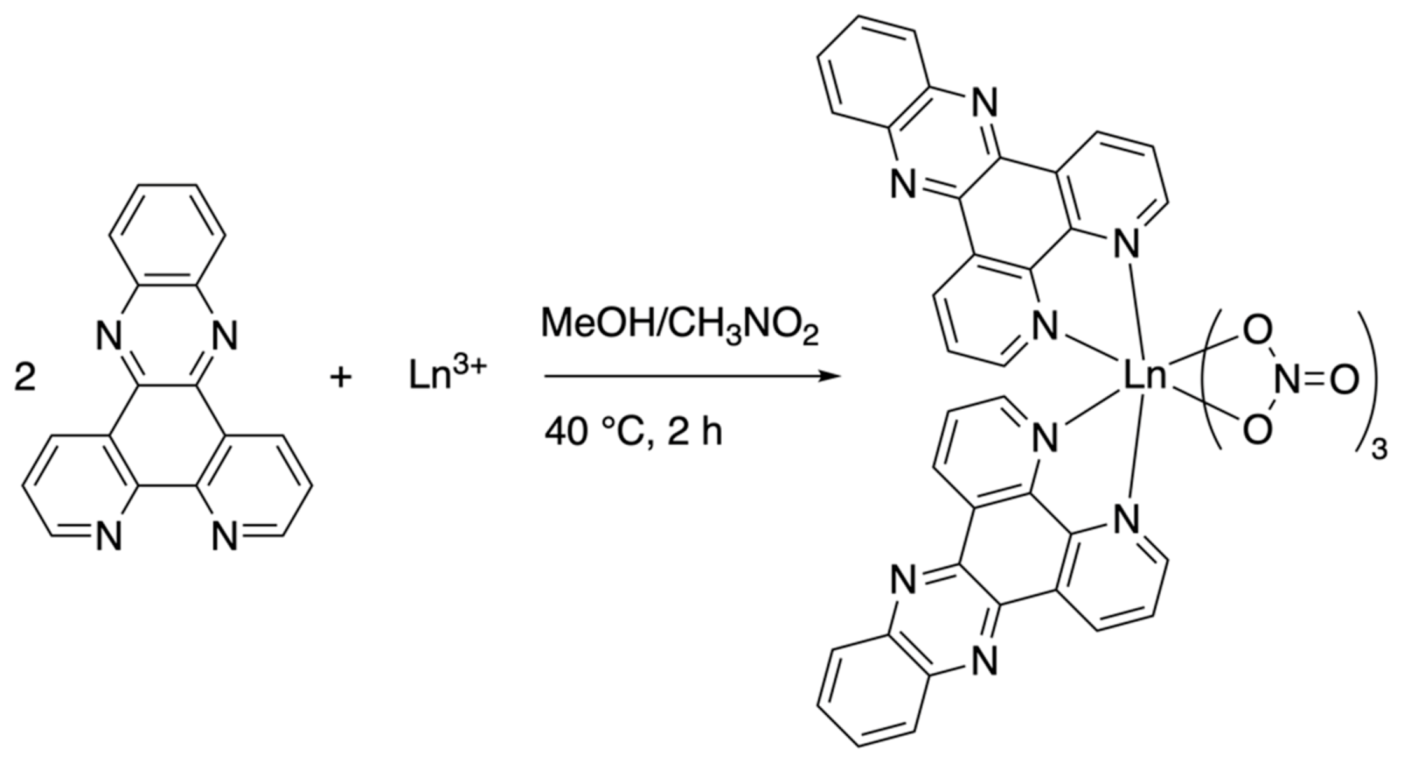
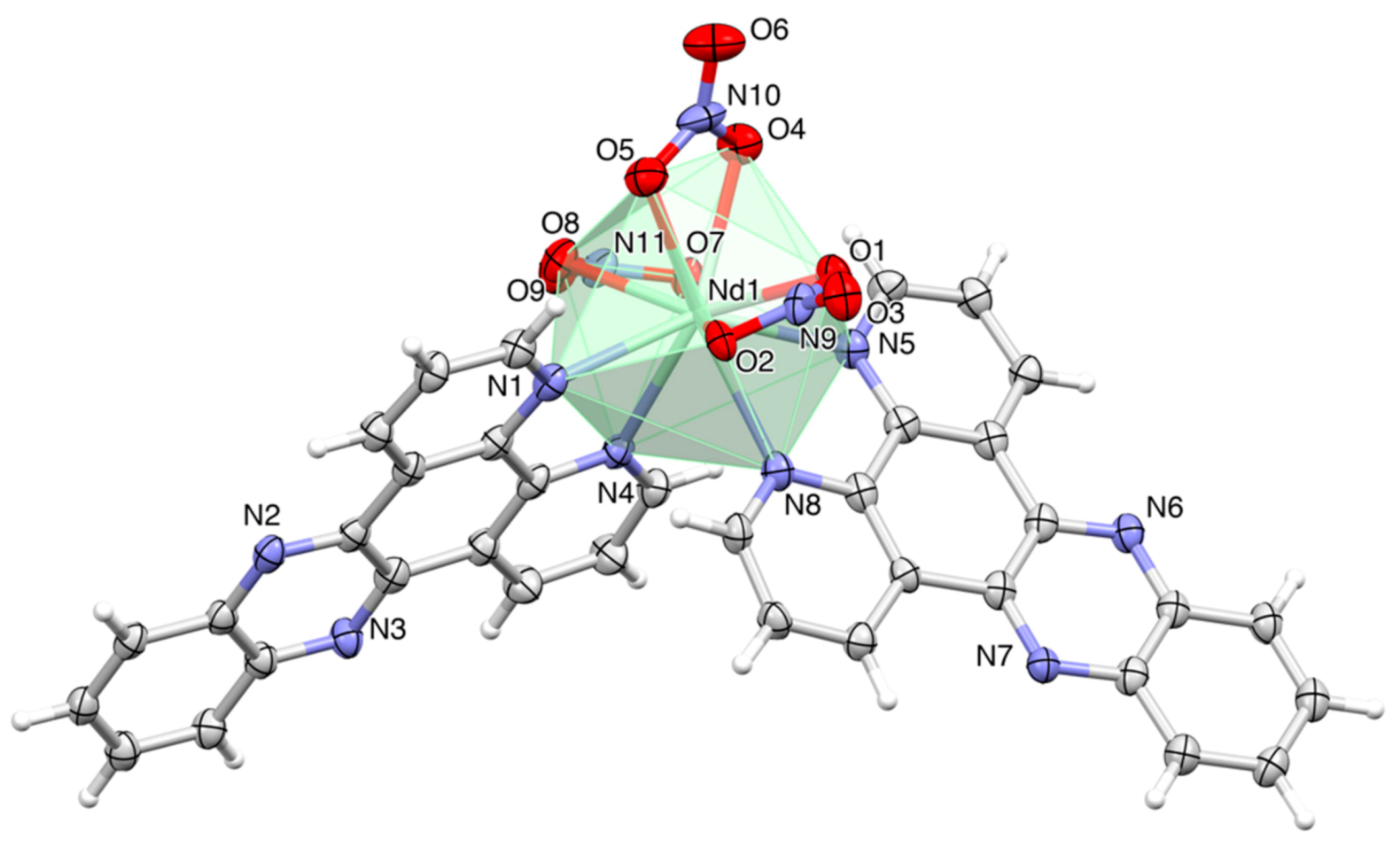
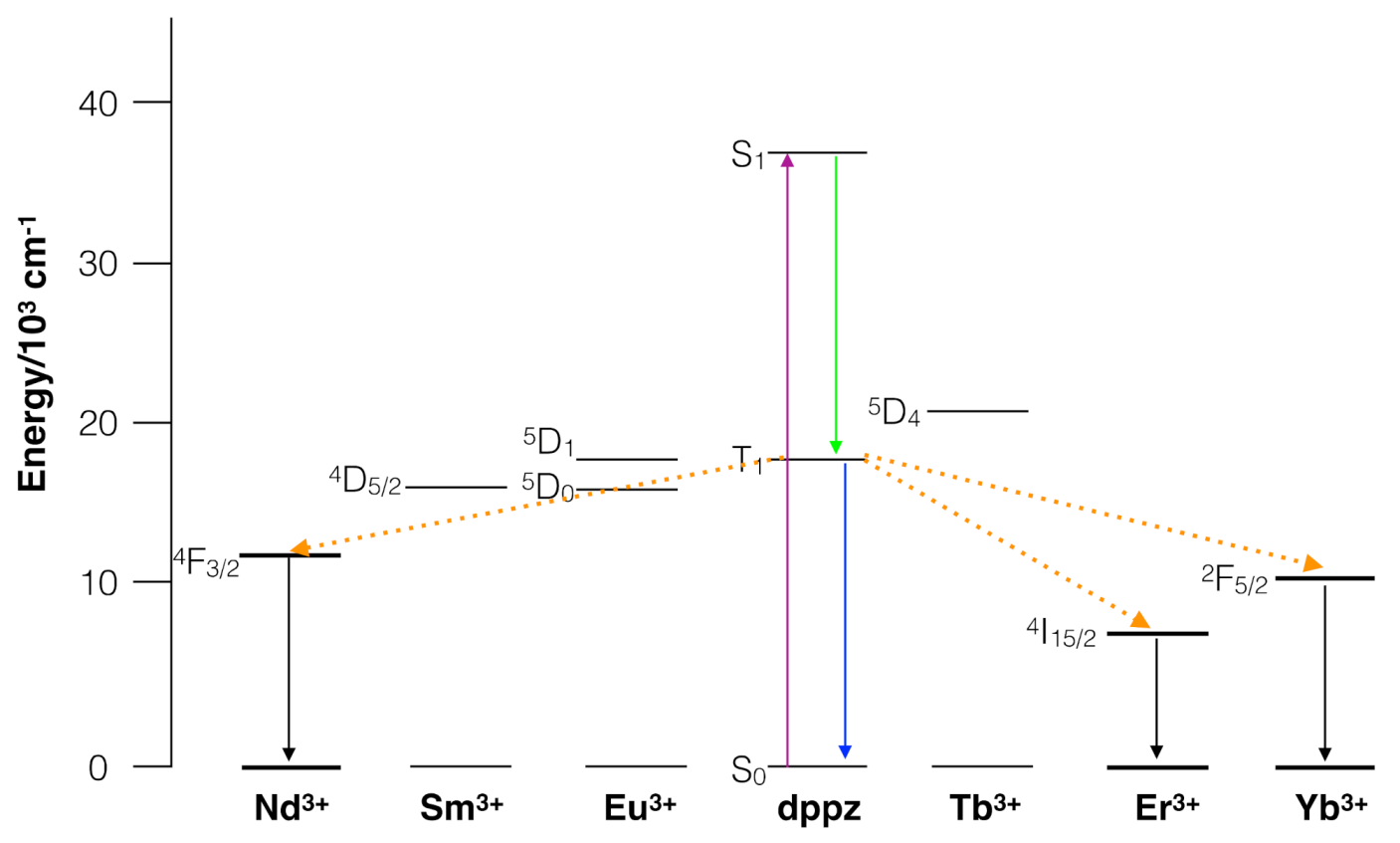
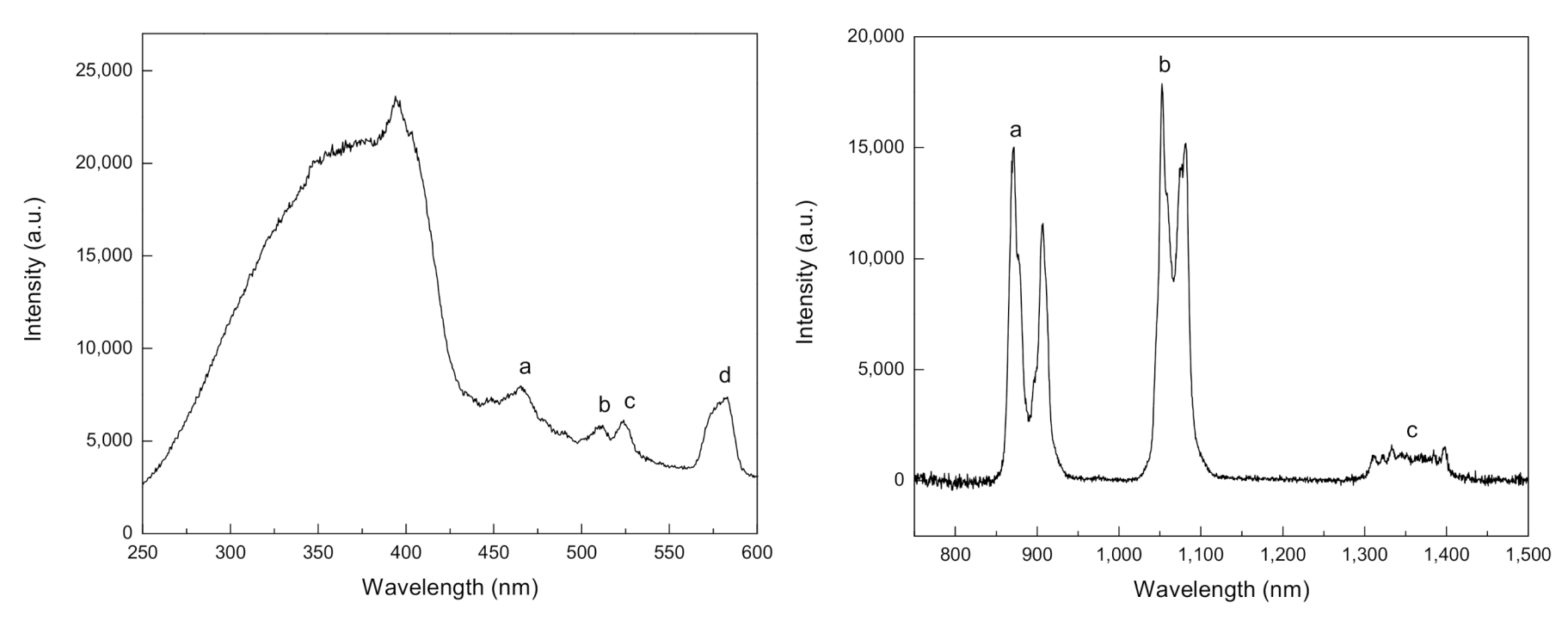


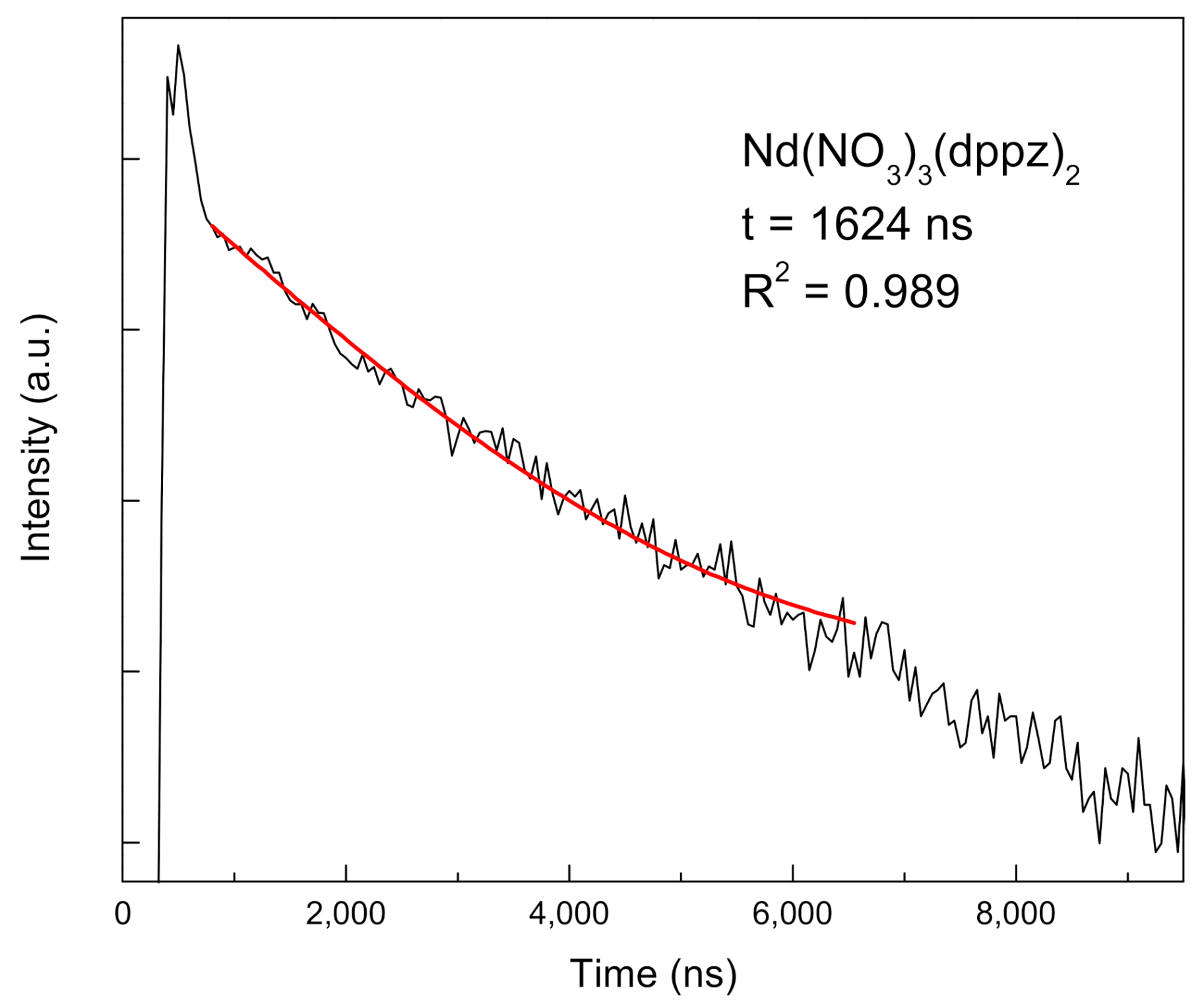
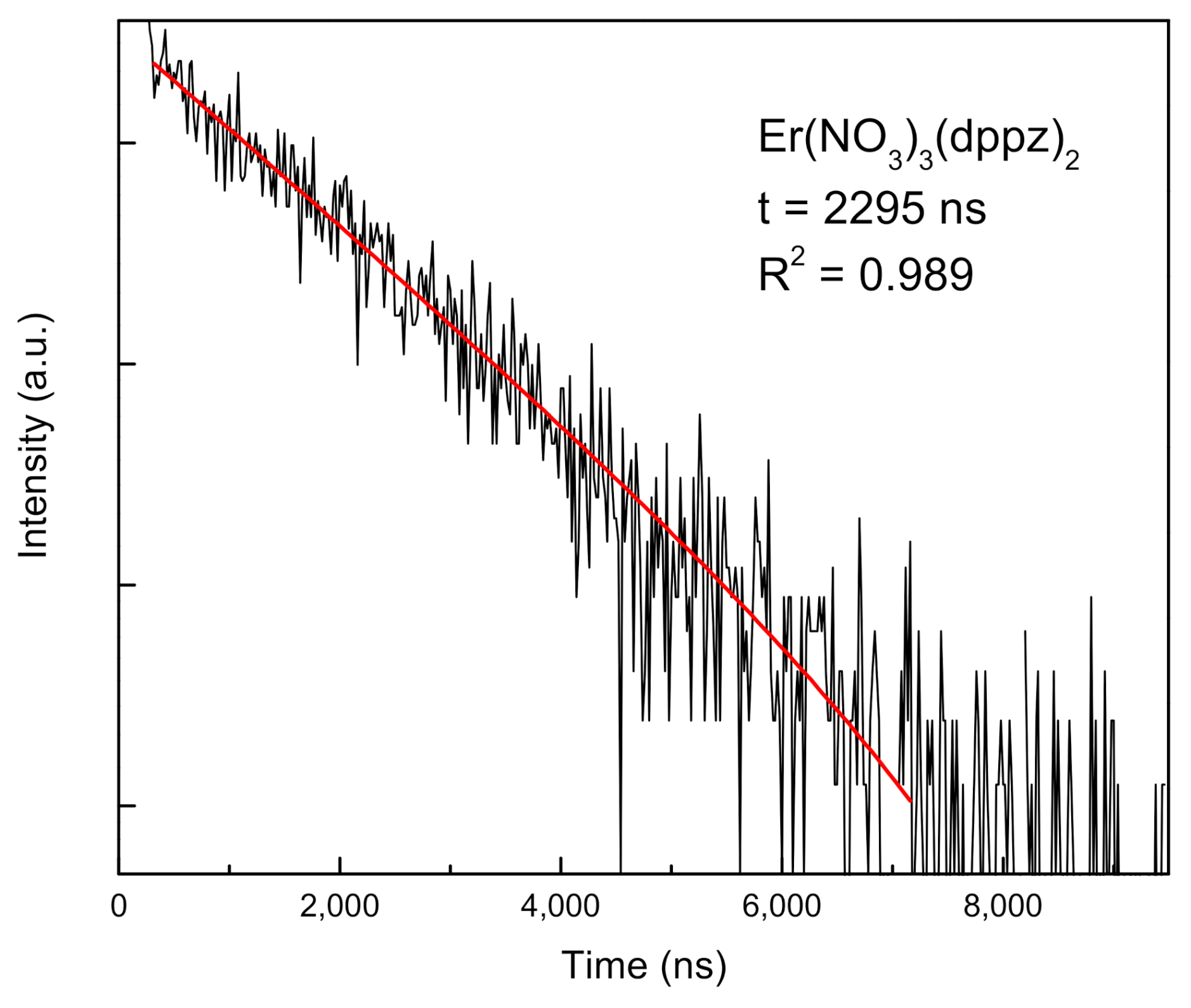
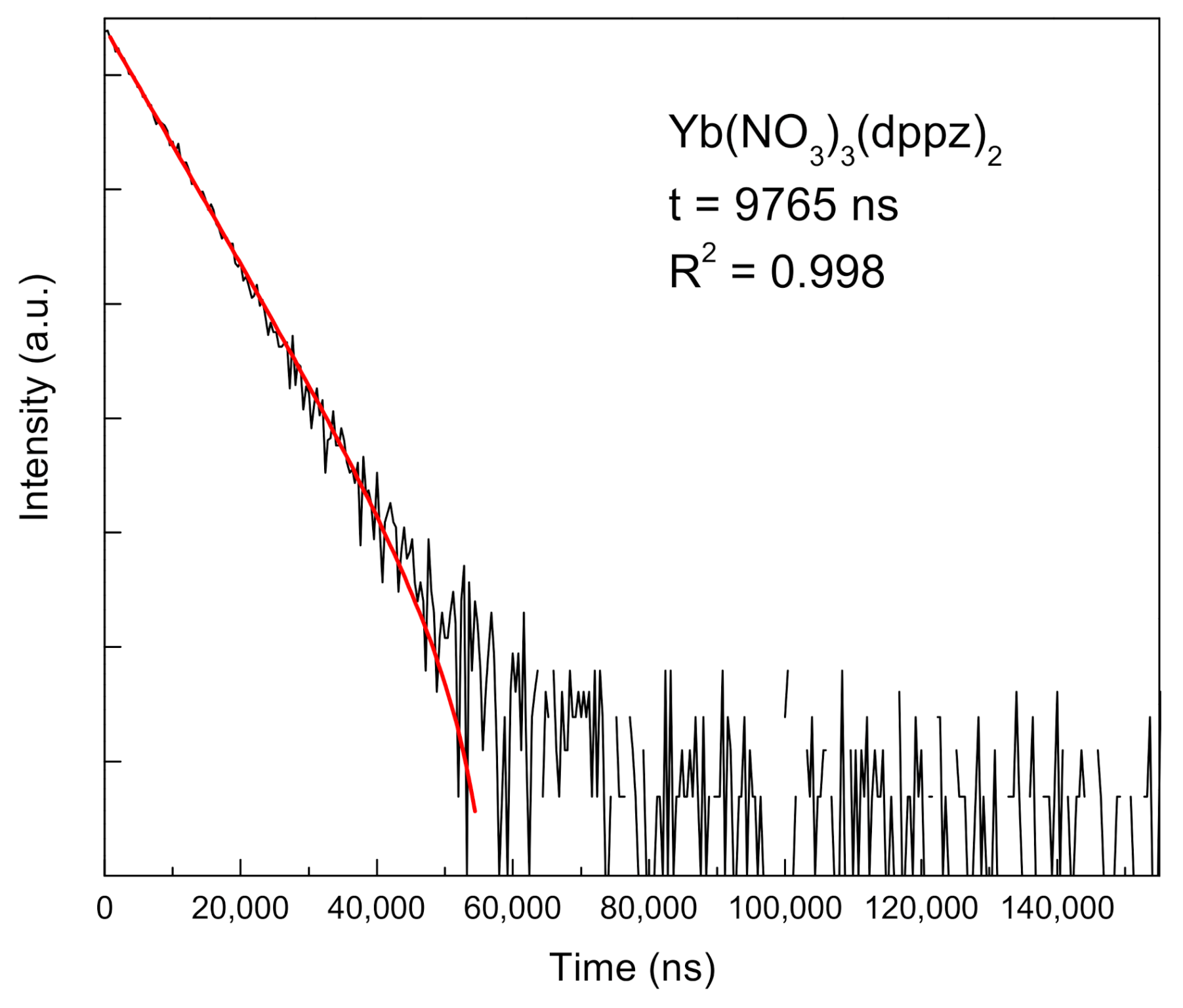
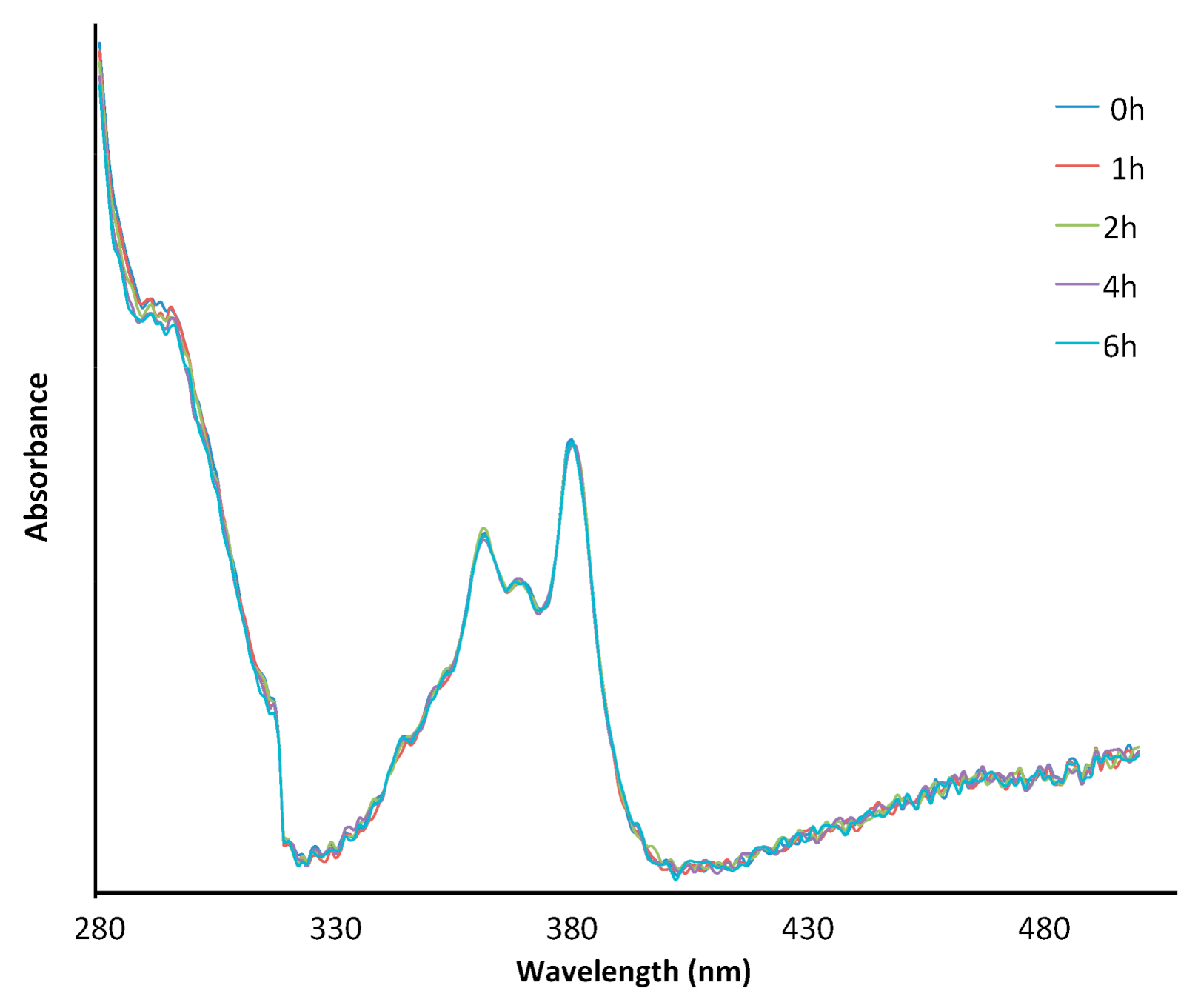

| Excitation | Emission | ||||||||
|---|---|---|---|---|---|---|---|---|---|
| Wavelength (nm) | Energy (cm−1) | Transition | Wavelength (nm) | Energy (cm−1) | Transition | ||||
| NdL | |||||||||
| a | 465.5 | 21482 | 2D3/2, 2P3/2, 2G9/2, 2K15/2 | ←4I9/2 | a | 870.8 | 11484 | 4F3/2 → | 4I9/2 |
| b | 512.2 | 19524 | 4G9/2, 4G7/22K13/2 | ← 4I11/2 | b | 1052.7 | 9499 | 4I11/2 | |
| c | 524.3 | 19073 | 4G9/2, 4G7/2, 2K13/2 | ←4I9/2 | c | 1334.5 | 7493 | 4I13/2 | |
| d | 582.4 | 17170 | 2G7/2, 4G5/2 | ←4I9/2 | |||||
| ErL | |||||||||
| no f-f transitions | a | 1529.0 | 6548 | 4I13/2 → | 4I15/2 | ||||
| YbL | |||||||||
| no f-f transitions | a | 977.6 | 10229 | 2F5/2 → | 2F7/2 | ||||
Publisher’s Note: MDPI stays neutral with regard to jurisdictional claims in published maps and institutional affiliations. |
© 2020 by the authors. Licensee MDPI, Basel, Switzerland. This article is an open access article distributed under the terms and conditions of the Creative Commons Attribution (CC BY) license (http://creativecommons.org/licenses/by/4.0/).
Share and Cite
Savić, A.; Kaczmarek, A.M.; Van Deun, R.; Van Hecke, K. DNA Intercalating Near-Infrared Luminescent Lanthanide Complexes Containing Dipyrido[3,2-a:2′,3′-c]phenazine (dppz) Ligands: Synthesis, Crystal Structures, Stability, Luminescence Properties and CT-DNA Interaction. Molecules 2020, 25, 5309. https://doi.org/10.3390/molecules25225309
Savić A, Kaczmarek AM, Van Deun R, Van Hecke K. DNA Intercalating Near-Infrared Luminescent Lanthanide Complexes Containing Dipyrido[3,2-a:2′,3′-c]phenazine (dppz) Ligands: Synthesis, Crystal Structures, Stability, Luminescence Properties and CT-DNA Interaction. Molecules. 2020; 25(22):5309. https://doi.org/10.3390/molecules25225309
Chicago/Turabian StyleSavić, Aleksandar, Anna M. Kaczmarek, Rik Van Deun, and Kristof Van Hecke. 2020. "DNA Intercalating Near-Infrared Luminescent Lanthanide Complexes Containing Dipyrido[3,2-a:2′,3′-c]phenazine (dppz) Ligands: Synthesis, Crystal Structures, Stability, Luminescence Properties and CT-DNA Interaction" Molecules 25, no. 22: 5309. https://doi.org/10.3390/molecules25225309
APA StyleSavić, A., Kaczmarek, A. M., Van Deun, R., & Van Hecke, K. (2020). DNA Intercalating Near-Infrared Luminescent Lanthanide Complexes Containing Dipyrido[3,2-a:2′,3′-c]phenazine (dppz) Ligands: Synthesis, Crystal Structures, Stability, Luminescence Properties and CT-DNA Interaction. Molecules, 25(22), 5309. https://doi.org/10.3390/molecules25225309








